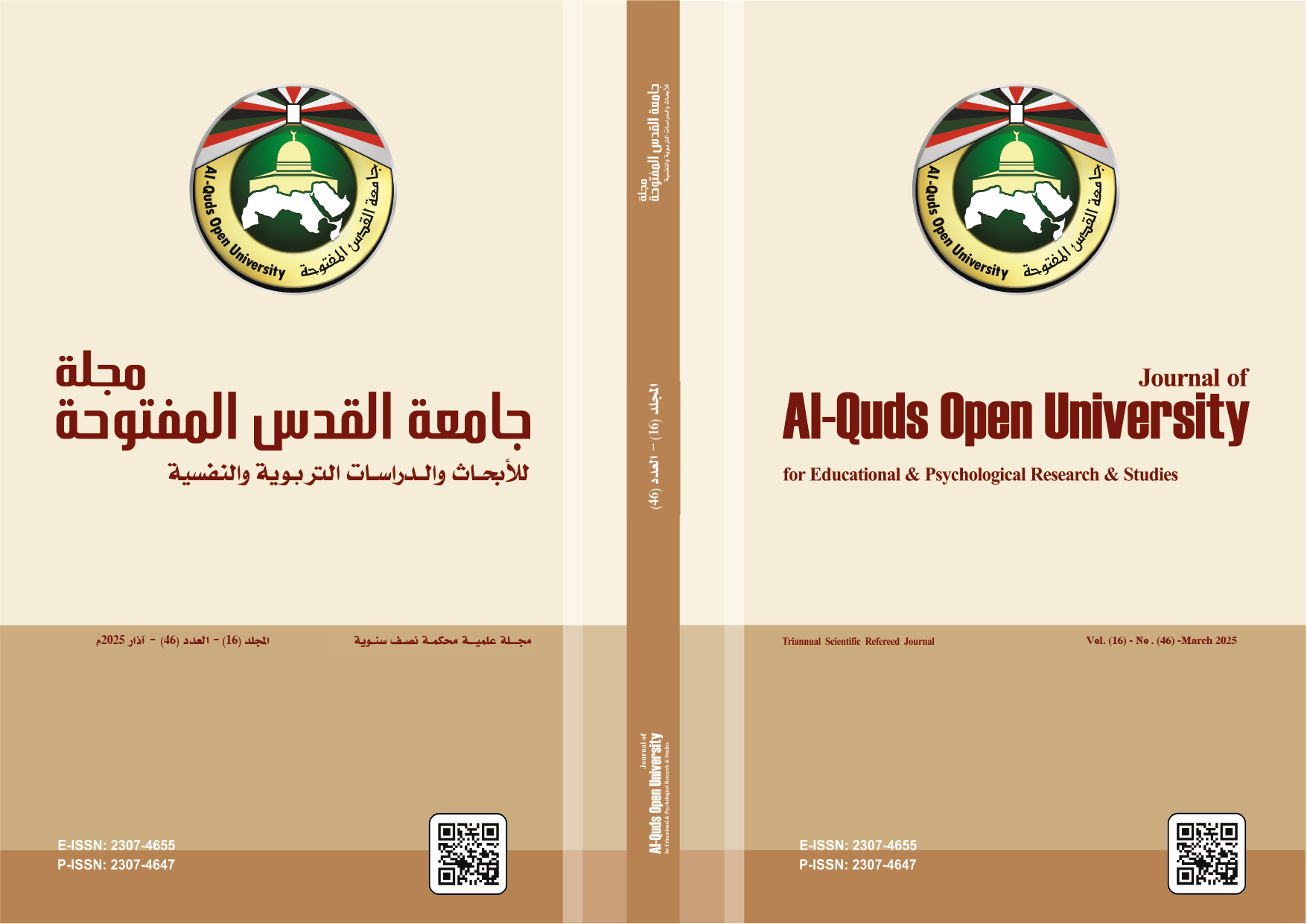The Big Five Personality Traits and its Relationship to Self- Awareness Among an- Najah National University Students – Palestine
DOI:
https://doi.org/10.33977/1182-016-046-017Keywords:
Big five traits of personality, self-awarenessAbstract
Objective: The current study aimes to find out the nature of the relation between the Big five traits of personality and self-awareness among An-Najah National University students. It also aims to identify the level of each of the big five personality traits and self-awareness, and the impact of each of the independent variables on the variables of the study.
Methods: The study sample includes 250 students divided into 74 males and 176 females from different colleges. Data were collected using the self-awareness scale, and the big five personality traits scale.
Results: The study find that four personality traits are highly prevalent among students, with the element of neuroticism showing up at a low level. University students have a high degree of self-awareness, according to the findings.
Conclusions: A positive relationship between consciousness and self-awareness as well as a negative relationship between neuroticism and self-awareness have also been found. Females were more neurotic trait than males.
References
References:
Abu Jarad, H, Judeh, A. (2013). The Big Five personality traits as predictors for a sample of Al-Quds Open University students. Journal of Al-Quds Open University for Research and Educational and Psychological Studies, 2 (6), 45-70.
Abu Rizk, M. (2011). The characteristic features of people with learning difficulties and their relationship to attention and some variables. (Unpublished master thesis), Islamic University, Gaza.
Ackerman, C. (2020). Big Five Personality Traits: The OCEAN Model Explained. Retrieved from Positive Psychology: https://positivepsychology.com/big-five-personality-theory.
Adas, A,. & Touq, M. (2009). Introduction to Psychology. Amman: Dar Al-Fikr Publishers and Distributors.
Ahmadi,H. (2013). Development of the Big Five Personality Traits Scale. Journal of Studies in Educational Sciences, 40 (3), 945-966.
Al-Akayishi, B. (2019). The relationship of self-awareness to the power of cognitive control among University of Sharjah students. Journal of Arts (129), 295-330.
Al-Amiri, S. (2015). Attachment patterns and their relationship to subject personality traits among students of Umm Al-Qura University in light of some variables. (Unpublished master Thesis), Umm Al-Qura University, Kingdom of Saudi Arabia.
Al-Ansari, B. (1997). The efficiency of the list of the five subject traits of personality in Kuwaiti society. Journal of Psychological Studies, Egyptian Psychologists Association, 7 (2), 277-310.
Al-Ansari, B. (2002). The reference in personality metrics: codification of Kuwaiti society. Kuwait: Modern Book House for Publishing, Printing and Distribution.
Al-Ansari, B. (2006). Personality measurement. Kuwait: Modern Book House for Publishing, Printing and Distribution.
Al-Atani, H. (2000). Psychological health. Amman: Dar Al-Fikr for Printing and Publishing.
Al-Fatlawi. H. (2023). Personal Initiative and its Relation to the Self-Awareness among University Students. Nasaq, 40(3). 1357-1373.
Al-Shaya, A,. & Al-Masry, W. (2011). The concept of self-awareness from childhood to youth from the perspective of developmental philosophy and psychology. Journal of Research and Studies, 8 (12), 267-290.
Al-Shorbaji, N,. & Daniel, A. (2002). Psychology of personality. Cairo: The Anglo-Egyptian Library.
Al-Zubaidi, R. (2017). Psychological comfort and its relationship to self-awareness among university students. Journal of the College of Education, 1 (2), 149-174.
Albert, K. (2014). Personality styles: secrets and mysteries. Amman: A treasure house for global knowledge.
Backmann, J., Weiss, M., Schippers, M., & Hoegl, M. (2018). Personality traits, student resiliency, and the moderating role of achievement values in study progress. Learning and Individual Differences, (72), 39-48. doi:10.1016/j.lindif.2019.04.004
Bataineh, A,. & Hayajneh, A,. (2018). The five subject traits for revealing personality traits among students of the Faculty of Physical Education at Yarmouk University and the University of Jordan. Al-Manara Journal for Research and Studies, 24 (1), 57-90.
Belkacem, A,. & Qashashta, A,. (2013). Characteristics of psychosomatic patients. Journal of Social Studies and Research - Wadi University, 2 (1), 143-152.
Chamorro, T. (2018). Personality and individual differences. Amman: Dar Al-Fikr Publishers and Distributors.
Faiq, A,. (2003). General Introduction to Psychology. Cairo: The Anglo-Egyptian Library.
Faraj, T. (2002). Self-affirmation. Cairo: Dar Gharib for Printing, Publishing and Distribution.
Ghobari, T,. & Abu Shaira, K. (2015). Psychology of personality. Amman: Al-Twyar Al-Alami House for Publishing and Distribution.
Hassoun, F,. & Sadiq, D,. (2019). Reflective thinking and its relationship to self-awareness among middle school students. Karbala University Scientific Journal, 17 (2), 44-58.
HBR, s. (2012). On necessities: If you haven't read anything about necessities, you should read this book. Riyadh: Al-Obeikan Publishing.
Hijazi, M. (2012). A dictionary of psychology terms, Arabic, English, and French. Lebanon: House of Scientific Books
Hilal, S. (2017). The five subject traits of personality and its relationship to creative thinking among Palestinian university students. (Unpublished masterThesis), Al-Quds University, Al-Quds-Palestine.
Igbinovia, M. (2016). Emotional Self Awareness and Information Literacy Competence as Correlates of Task Performance of Academic Library Personnel. ResearchGate. Retrieved from ResearchGate.
Khalidi, A. (2014). Self-awareness and its relationship to psychological compatibility among high school students. (Unpublished master thesis), King Abdulaziz University, Kingdom of Saudi Arabia.
McCrae, R. R., & Costa, P. T. (1999). A Five-Factor Theory of Personality. In L. A. Pervin & O. P. John (Eds.), Handbook of Personality: Theory and Research (2nd ed., pp. 139-153). Guilford Press.
Muhammad H. (2012). The Five Traits of Personality: A new approach to studying and measuring personality structure. Cairo: The Anglo-Egyptian Library.
Muheisen, I. & Abed, Rawa'a and Jawad, M. (2017). The artificial personality and its relationship to self-awareness among students of Al-Qadisiyah University. (Unpublished graduation project), University of Al-Qadisiyah, Iraq.
Mustafa, Y. & Bettou, A. (2006). The five subject traits in personality and their relationship to the achievement of self-evaluation among university students. The Journal of Arts, (77), 224-260.
Osmon, D., Santos, O., Kazakov, D., Kassel, M., Mano, Q., & Morth, A. (2018). Big Five personality relationships with general intelligence and specific Cattell-Horn-Carroll traits of intelligence. Personality and Individual Differences, (131), 51-56. doi.org/10.1016/j.paid.2018.04.019
Plomin, Robert & DeFries, J. & McClearn, G. & Mcguffin, Peter. (2001). Behavioral Genetics, 4th Ed.
Rabia, A. (2016). The relationship of personality traits according to the big five traits model with emotional intelligence among nurses in Oran state. (Unpublished master thesis), University of Oran, Algeria.
Sabbar, H. M. (2023). Self-Awareness and its Relationship to Emotional Creativity among University Students. Journal of Tikrit University for Humanities, 30 (2), 323- 350. DOI: http://dx.doi.org/10.25130/jtuh.30.2.1.2023.15
Salloum, A. (2001). Personal. Al-Naba 'Magazine (54).
Shahsavarani, A', Ashayeri, H', Sharif, Y', Lotfian, M', Sattari, K', Mohammadi, M', & Hosseini, I'. (2013) Personality Traits (Five-Factor Model, FFM) in Persian Male & Female Students: The Role of Brain Asymmetries. Journal of American Science, 9(6), 490-498.
Shara, H. (2012). The predictive power of the Big Five traits in personality with irrational thoughts. Journal of Educational Sciences. Psychology, 13 (2), 245-272.
Taha, F, & Abu Al-Nil, M, and Qandil, S, and Muhammad, H, and Abdel-Fattah, M. (2005). Dictionary of Psychology and Psychoanalysis. Beirut: Arab Renaissance House for Printing and Publishing.
Young, R. (2011). Character: How to unleash your hidden powers. Riyadh: Jarir Bookstore.
Downloads
Published
How to Cite
Issue
Section
License
Copyright (c) 2025 Journal of Al-Quds Open University for Educational & Psychological Research & Studies

This work is licensed under a Creative Commons Attribution 4.0 International License.
- The editorial board confirms its commitment to the intellectual property rights
- Researchers also have to commit to the intellectual property rights.
- The research copyrights and publication are owned by the Journal once the researcher is notified about the approval of the paper. The scientific materials published or approved for publishing in the Journal should not be republished unless a written acknowledgment is obtained by the Deanship of Scientific Research.
- Research papers should not be published or republished unless a written acknowledgement is obtained from the Deanship of Scientific Research.
- The researcher has the right to accredit the research to himself, and to place his name on all the copies, editions and volumes published.
- The author has the right to request the accreditation of the published papers to himself.







2.png)






_2.png)

